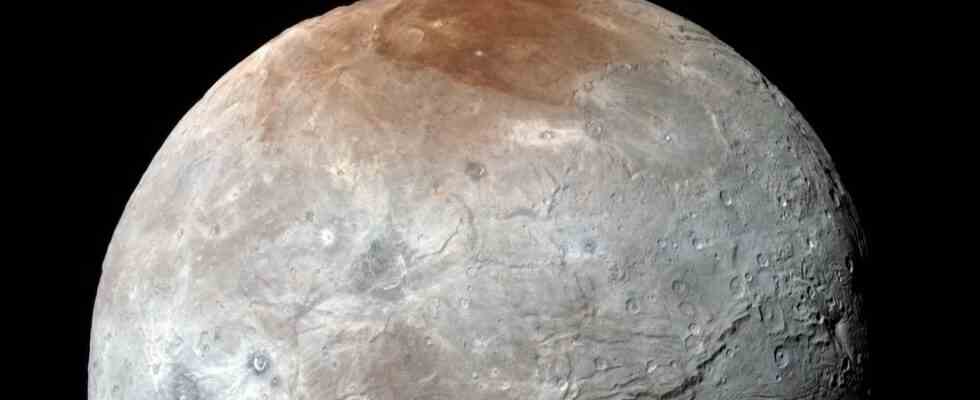The validity of the saying “All cats are gray at night” can be confirmed by astronomers, especially when studying celestial bodies in the outer solar system. They are all the happier when they discover that the places they long for are more colorful than they thought.
When the US astronomer James W. Christy accidentally discovered Charon, the largest moon of the dwarf planet Pluto, in 1978, he had the picture no more than a gray bump at the edge of a blurry patch of light seen. Not until the NASA spacecraft New Horizons In 2015, when it flew by Charon at a distance of almost 30,000 kilometers, the astronomers discovered a neat red blob in the northern polar region, a little fainter but optically comparable to a red spot that Jupiter also has. However, Charon’s cutie mark has a completely different cause.
Scientists quickly speculated that the stain might be tholin-like substances. After that, a brownish-red mixture of hydrocarbons would cover a nearly 500-kilometer-wide lowland at the North Pole – informally called “Mordor Macula” by astronomers, after the dark realm in JRR Tolkien’s “Lord of the Rings”.
It is true that this assumption has not yet been directly proven. Charon and Pluto are currently about five billion kilometers away from us and New Horizons was the only visitor so far. However, in two related studies, scientists now have the atmospheric conditions on Charon experimentally reproduced and theoretically modeled. “Until now, no one has been able to directly detect the composition of such tholins,” says Ujjwal Raut of the Southwest Research Institute in Texas, who was a lead and co-author on both studies. “However, our experiments strongly suggest that complex hydrocarbons can form from methane ice via energetic processes.”
The required methane does not come from Charon, but from neighboring Pluto. The moon, measuring 2,300 kilometers, and its main body, which is just twice as large, form a system that orbits each other at a distance of less than 20,000 kilometers. So Charon keeps flying through a cloud of methane ejected by Pluto. Charon’s gravity traps numerous gas molecules, which then bounce across its surface until they are caught in the extreme cold of the polar lowlands, the study authors said. Since the Charon-Pluto system takes 248 years to complete one orbit around the sun and is also tilted sharply out of the orbital plane, Charon, like Earth, has distinct seasons. Temperatures in deep-lying cold traps can therefore drop to less than minus 260 degrees Celsius during the 124-year Charon winter. Hence even the fugitive methane settles there as ice until it thaws in the early Charon spring and continues its journey across the surface into the next winter.
However, a small part of the methane ice is photolytically broken down by ultraviolet radiation and converted into other substances, primarily into slightly larger and longer-lived ethane molecules. However – even ethane ice is transparent. “The photolysis of methane alone cannot explain the red color,” says Raut. “Therefore, the solar wind should also process the ethane to produce longer, reddish hydrocarbons. But we have yet to find out exactly what these molecules are.”
Such planetary gas transfers are unique in the solar system, says Raut, because no other planetary celestial body comes as close as Pluto and Charon. The icing processes at the poles cannot be compared with those on Earth or Mars either. “We estimate that about 80 individual layers of photoproducts accumulate at the poles in a Pluto year,” says Raut. “Over millions of years, these will probably grow to several micrometers in thickness.” For comparison: aluminum foil is about 15 microns thick.

